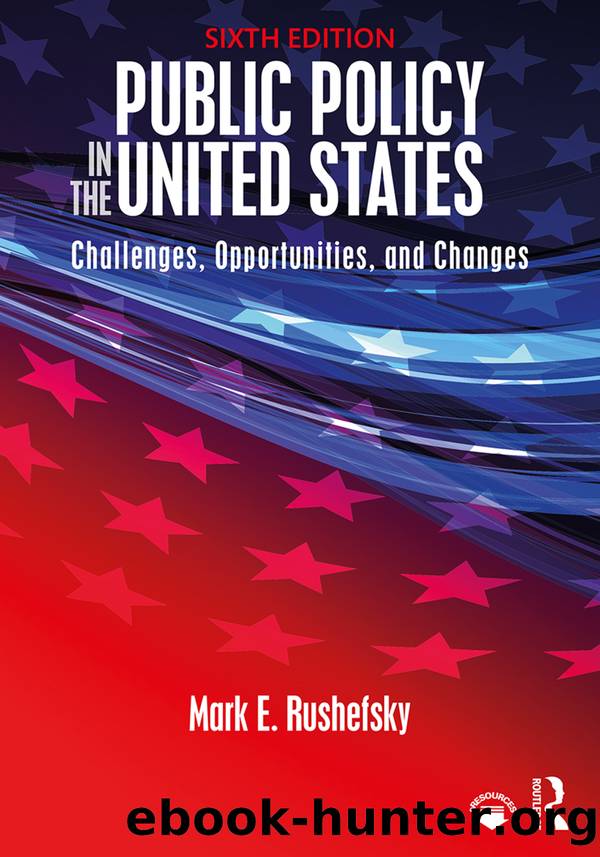Public Policy in the United States by Mark E. Rushefsky

Author:Mark E. Rushefsky [Rushefsky, Mark E.]
Language: eng
Format: epub
Tags: Public Policy, Political Ideologies, Political Science, Nationalism & Patriotism, American Government, Economic Policy, General
ISBN: 9781317461722
Google: 7D3fBQAAQBAJ
Goodreads: 24048397
Publisher: Routledge
Published: 2013-07-15T00:00:00+00:00
Policy Formulation: Kingdonâs Multiple Streams Model
As with other policy issues discussed in this book, we can use the stages of the policy process to help us understand how health care reform came to pass. Kingdonâs (2002) multiple streams model provides a framework for the beginning portions of the policy process.
The first of the streams, the problems stream, focused on cost and access, the same ones that faced the Democrats and the Clinton administration in 1993. By 2008, it was clear that the problems were no nearer a solution.
In 1993, national health care expenditures equaled about 13.7 percent of GDP. By 2008, that number had climbed to 16.2 percent (Centers for Medicare and Medicaid Services, n.d.). While the percentage of the population lacking health insurance was just a little more in 2008 (15.7 percent) than in 1993 (15.3 percent), the numbers of people were much higher: a little under 40 million people lacked insurance in 1993 compared to more than 46 million in 2008 (see Table 5.3). Costs for health care continued to be a problem for employers.
One new element that appeared in 2009 but not in 1993 was the economy. First, the economy went into a deep recession in late 2007. When that happens, people lose jobs and the health insurance that comes with it. They either become uninsured or try to go on Medicaid, which affects state and federal budgets. A second related economic issue was that the financial burden of health care costs was increasingly impacting middle- and upper-income families (see, e.g., Cunningham 2010). A related point is that many of the home mortgage bankruptcies that helped cause the recession were related to overwhelming health care costs (Robertson, Egelhof, and Hoke et al. 2008). Indeed, more than half of all personal bankruptcies were due to medical costs (Himmelstein et al. 2009)
Health care costs were also impacting governments. The states were faced with a double blow from the recession. On the one hand, the recession resulted in lower tax revenue, because there were fewer people working, so spending declined. On the other hand, there was greater demand for Medicaid services, so there were pressures on the expenditure side.
The federal government faced similar problems. The bailouts and economic stimulus programs (see Chapter 2) resulted in massive increases in spending at a time when tax revenues were falling. Like the states, the federal government faced increased spending on Medicaid. And it also experienced increased spending on Medicare as more people retired because they could not find work. Medicare revenue declined.
The second stream in the Kingdon (2002) model is the policy stream. As discussed in Chapter 1, the multiple streams model sees policy proposals and their advocates waiting for the opportune moment to attain the policy agenda. While this chapter does not have sufficient space to consider all the suggestions (see Patel and Rushefsky 2014), it lists some of them and then focuses on one in particular.
Advocates of reform favored a single-payer system, in which the federal government would collect taxes and pay for services.
Download
This site does not store any files on its server. We only index and link to content provided by other sites. Please contact the content providers to delete copyright contents if any and email us, we'll remove relevant links or contents immediately.
The Art of Coaching Workbook by Elena Aguilar(50957)
Trainspotting by Irvine Welsh(21515)
Twilight of the Idols With the Antichrist and Ecce Homo by Friedrich Nietzsche(18501)
Fangirl by Rainbow Rowell(9093)
Periodization Training for Sports by Tudor Bompa(8166)
Change Your Questions, Change Your Life by Marilee Adams(7630)
This Is How You Lose Her by Junot Diaz(6777)
Asking the Right Questions: A Guide to Critical Thinking by M. Neil Browne & Stuart M. Keeley(5627)
Grit by Angela Duckworth(5511)
Red Sparrow by Jason Matthews(5389)
Paper Towns by Green John(5086)
Room 212 by Kate Stewart(5034)
Ken Follett - World without end by Ken Follett(4641)
Housekeeping by Marilynne Robinson(4328)
The Sports Rules Book by Human Kinetics(4288)
Double Down (Diary of a Wimpy Kid Book 11) by Jeff Kinney(4203)
Papillon (English) by Henri Charrière(4193)
The Motorcycle Diaries by Ernesto Che Guevara(4008)
Exercise Technique Manual for Resistance Training by National Strength & Conditioning Association(3953)
